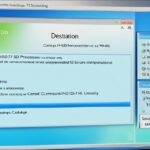Table of Contents
In today’s world, keeping a backup of your data is essential. Many people and companies don’t realise how important it is to have a good backup system for their hard drives. This can lead to loss of important data due to things like technical failures or online security attacks. Surprisingly, the most common reason for losing data is simple mistakes made by people. This highlights the importance of having a solid plan for backing up data1. It’s crucial to follow the three-backup rule: keep the original data, a copy of that data, and a copy of the copy. This ensures protection from unexpected disasters2. There are many ways to keep your HDD data safe, including storing it locally or online. Each method has its own benefits depending on what you need. And with the cost of storage always changing, finding the most efficient way to backup has become very important2.
This article explores the best ways to backup your HDD. It provides important details about the different backup options, tips for regular backups, and advice on how to get your data back when needed.
Key Takeaways
- Regular backups can protect against data loss from hardware failures.
- Cloud storage can enhance backup capabilities but may require manual selection of files.
- Local backups are susceptible to loss, damage, and theft.
- Implementing a three-copy backup strategy optimises data loss prevention.
- Utilising reliable backup software accelerates the recovery process.
- Automating backups reduces the likelihood of human error in the background process.
- Understanding the limitations of built-in backup solutions is crucial for effective data protection.
Understanding Backup Basics
Learning about data backup is crucial today, as our data is more at risk than ever. A backup simply means a copy of your files saved elsewhere to prevent loss. You can store backups on things like external hard drives, online in the cloud, or on other drive partitions. It’s vital to know what counts as a backup. For example, syncing files isn’t the same since it might not keep old versions, risking data loss3. It’s generally advised to have three versions of all important files: the main one, a backup, and another backup for extra safety4.
What is a Backup?
Think of a backup as a safety net for your files. It helps you get back lost files if your hardware fails or corrupts. This idea is key in data protection plans, keeping important stuff like documents and photos safe. The value of backups is huge. Plus, automated tools make backing up both quicker and easier3.
What a Backup is Not
Some mix up saving files with actual backups. Using cloud services like Google Drive or Dropbox isn’t really backing up, especially if old versions aren’t kept3. True backup methods are more than just copy-paste tasks. Simple copying misses out on important data and settings5.
Why Backups Are Essential
Backups are critical because hard drives can fail. Recovery can cost a lot, sometimes thousands3. A good backup plan saves time, work, and money if data loss happens. Experts suggest the 3-2-1 backup rule. It stresses keeping several backups in different places to protect against failures or data corruption5.
Available Backup Options
Today, keeping our data safe is super important. We can choose from local backup methods or online backup solutions. Each has its own good and bad points.
Local Backup Methods
Local backups mean keeping data on things like external hard drives or USBs at home. They’re fast and give you control. But, they can get damaged or stolen. Experts say that mixing local and cloud backups is best. Follow the 3-2-1 rule: three data copies, on two different media, with one copy somewhere else6.
Online Backup Solutions
Online backups use the cloud, letting us save files remotely through services like Backblaze, IDrive, and Acronis True Image. This keeps our files safe from local troubles, and we can get to them anytime if we have internet6. However, you’ll need a good internet connection for this to work well.
Thinking about how to back up your files? A hybrid strategy is best. It combines local and online backups. This guide shows how combining the two gives the most secure way of storing data.
How to Backup HDD
Backing up your hard drive is a must to protect your data from loss. Windows and Mac users can find easy solutions for backups. They can also use third-party backup software for more options and automation.
Backing Up with Windows
Windows has built-in features for backing up HDDs, like Backup and Restore, and File History. A full system backup may need more than 200 GB of space. So, you’ll need an external hard drive with at least 250 GB free7. To start a backup in Windows 10, go to the Control Panel. Then select Backup and Restore (Windows 7), and create a system image on an external drive7.
Despite these features, many new users choose manual backup. They find it offers a clearer way to meet their backup needs8.
Backing Up on Mac
Mac users have Time Machine for easy automatic system backups. You should start a new APFS volume on an external drive for this7. Time Machine is quite popular among Mac users. Many choose it as their go-to backup solution8.
Using Third-Party Software
Third-party backup tools like Acronis True Image or EaseUS Todo Backup provide extra options. These include disk imaging and custom backup schedules2. They offer strong features for restoring data and are easy to use. Many Windows users appreciate EaseUS for effective backup tasks, showing its value in data security8.
Setting Up a Backup Schedule
Creating a good backup schedule is key to keeping your data safe and current. Windows users can automate backups using File History or Backup and Restore. These tools regularly copy data, improving your data management and preventing data loss.
Automating Windows Backups
EaseUS Todo Backup is great for setting up automated backups. It lets you choose daily, weekly, or monthly schedules. This software makes backing up quick and can save data to external drives, which keeps your important files safe.
With encryption and advanced compression, EaseUS makes automated backups straightforward. You can back up files, entire partitions, the operating system, and apps9. Setting up your backup schedule with EaseUS reduces the risk of overlooking data updates10.
Scheduling Backups on macOS
macOS’s Time Machine makes scheduled backups easy. It backs up data hourly, keeping your copies up-to-date. Time Machine saves only new changes, saving storage space.
This approach enhances your data management by using both local and external backup options. It offers strong protection for your personal information and documents. With regular use, Time Machine keeps your valuable data safe, giving macOS users confidence in their data integrity.
Restoring Data from a Backup
Knowing how to get back your data is crucial. Every operating system offers ways to recover lost files. This makes sure the recovery process goes smoothly.
Recovering Files on Windows
Windows users have several ways to recover data. The Recycle Bin is often the first stop, as it may still hold deleted files. Should the files be missing there, the File History feature is available. It lets users bring back lost documents from an existing backup11.
In serious data loss cases, using professional recovery software is a good move. Tools like Stellar Data Recovery Professional are great for finding and getting back missing data12. Knowing that mistakes like accidental deletion are common helps users act quickly13.
Restoring Data on Mac
For macOS users, Time Machine is a handy recovery tool. It allows quick access to earlier versions of files. This way, users can easily get back important documents11.
If data was deleted by mistake, checking the Trash Bin might help. For severe problems like physical damage, it’s often vital to seek professional recovery services. This is especially true for issues with the hardware13. Realising the value of good backups is key. It supports effective data recovery today12.
Conclusion
It’s crucial to have good backup strategies to protect important data from unexpected events. This includes family photos, key documents, or music collections. Understanding the importance of data backup is vital. Backing up data regularly can stop big losses from viruses, hard drive issues, or mistakes14. Users have various options for backup, like using Windows tools or third-party software, for HDD protection.
Making a backup routine that fits your needs is key for strong data management strategies. Tools like Windows’ File History, OneDrive, or EaseUS Todo Backup keep data safe. They also make data recovery simple if something goes wrong15. It’s smart to backup at least once a week to protect important info.
Lastly, by knowing and setting up automatic backup, everyone can improve their data security. Making backups a regular task is essential for safe data management. It keeps your information protected, secure, and ready to be restored if necessary.
FAQ
What is a backup and why is it important?
A backup is basically a copy of your data saved elsewhere to avoid losing it. It’s very important because it saves your information from being lost due to computer breakdowns, virus attacks, and unexpected situations.
What are the different methods for backing up data?
You can back up your data in two main ways. Local backups are kept on devices like external hard drives. Meanwhile, online backups are saved on cloud services such as Google Drive or Dropbox, offering protection from afar.
How often should I back up my data?
Setting up a regular backup schedule is a smart move. This means your data is always up to date and secure. Making this process automatic makes sure you don’t have to do it yourself every time.
Can I restore data from a backup easily?
Yes, getting your data back from a backup is usually easy. For instance, Windows offers tools like File History or Backup and Restore. Mac users have Time Machine for a smooth recovery process.
Is third-party backup software necessary?
Though your computer’s built-in backup functions work well, third-party software can offer more. Features like disk imaging, scheduling, and better backup management make them worth considering for keeping your data safe.
What if my local backup is lost or damaged?
Just having local backups might not be enough because they can be stolen or ruined. Mixing local and online backups is a good strategy to keep your data safe no matter what happens locally.
What is the rule of three in data backup?
The rule of three is about having three copies of your data. This includes your original data, one backup, and another backup. It’s a good way to make sure your data is extra secure.
How can I automate my backups on Windows and Mac?
Windows users have options like File History or Backup and Restore for automatic backups. Mac users can use Time Machine to set up automatic backups, such as every hour.
Are cloud storage options secure for backing up my data?
Yes, top-notch cloud storage services have strong security measures to keep your data safe. It’s important to choose reputable providers and use extra security features like two-factor authentication.
Source Links
- https://www.carbonite.com/personal/how-to/how-to-backup-computer/ – How to Backup Your Computer: Essential Steps for Data Safety and Security
- https://www.pcworld.com/article/448738/the-absurdly-simple-guide-to-backing-up-your-pc.html – The absurdly simple guide to backing up your PC
- https://www.acronis.com/en-us/blog/posts/backup-hard-drive/ – How to backup a hard drive and restore it? Step-by-Step Guide
- https://www.kingston.com/en/blog/personal-storage/how-to-backup-drives-windows-mac – How do you backup your computer? Windows and Mac drive backup- Kingston Technology
- https://www.easeus.com/databackup/backup-hard-drive.html – (2024) An Ultimate Guide to Backup Hard Drive and Restore Your Computer
- https://www.cisa.gov/sites/default/files/publications/data_backup_options.pdf – Data Backup Options
- https://www.lifewire.com/back-up-computer-to-external-hard-drive-5184117 – Back Up Your Computer to an External Hard Drive
- https://www.easeus.com/backup-utility/backup-and-restore-data.html – Hard Disk Backup in Windows 10/8/7 [Beginners’ Guide]
- https://www.easeus.com/backup-utility/automatically-backup-files-to-external-hard-drive.html – How to Automatically Backup Files to An External Hard Drive | 3 Ways
- https://www.toshiba-storage.com/trends-technology/how-to-create-a-computer-backup-on-an-external-hard-drive/ – How to Create a Computer Backup on an External Hard Drive?
- https://www.cleverfiles.com/howto/dead-hard-drive-recovery.html – How to Recover Data from a Dead or Damaged Hard Drive (2024)
- https://www.stellarinfo.com/article/recover-data-from-hard-drive.php – Top 6 Ways to Retrieve Data from Hard Drive?
- https://www.securedatarecovery.com/blog/how-to-recover-data-and-back-up-hard-drive – How To Recover Data And Backup A Hard Drive
- https://www.diskgenius.com/how-to/how-to-backup-computer-to-external-hard-drive.php – How to Backup Computer to External Hard Drive in Windows 10?
- https://www.easeus.com/backup-utility/how-to-backup-entire-hard-drive-windows-10.html – [99%’s Choice] How to Backup Entire Hard Drive Windows 10








